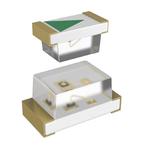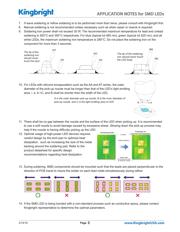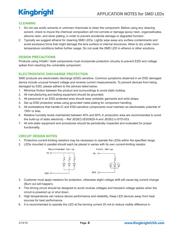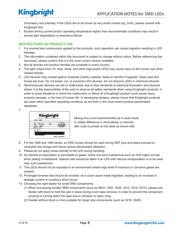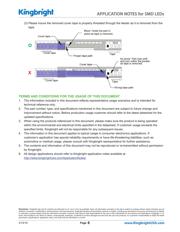下载

2/15/16
APPLICATION NOTES for SMD LEDs
1
Page
STORAGE CONDITIONS
SMD devices are usually moisture/reow sensitive. Moisture from atmospheric humidity enters permeable
packaging materials by diffusion. Assembly processed used to solder SMD packages to PCBs expose the entire
package body to temperature between 160° - 260°. During solder reow, rapid moisture expansion can result in
package cracking, delamination of critical interfaces within the package, or damaged gold wire.
1. Scope: Application notes listed in this document apply to SMD products include the AA, AP, AM, APK, and
AT series.
2. Unopened moisture barrier bag (MBB) shall be stored at temperature below 40° with humidity below
90%RH.
3. After the MBB has been opened, the LEDs should be used according to the oor life specied in the table
below.
LEVEL
FLOOR LIFE
LEVEL
FLOOR LIFE
TIME CONDITIONS TIME CONDITIONS
1 Unlimited ≤ 30°C / 85% RH 4 72 hours ≤ 30°C / 60% RH
2 1 year ≤ 30°C / 60% RH 5 48 hours ≤ 30°C / 60% RH
2a 4 weeks ≤ 30°C / 60% RH 5a 24 hours ≤ 30°C / 60% RH
3 168 hours ≤ 30°C / 60% RH 6 Time on Label (TOL) ≤ 30°C / 60% RH
4. If the Humidity Indicator Card (HIC)’s 10% mark has changed, or the LEDs have not been used within the
oor life specied, they should be baked with the following conditions to reset the oor life:
TYPE TEMPERATURE HUMIDITY BAKE TIME
When still in carrier tape 60 ± 3°C < 5%RH 100H
When out of carrier tape 110°C / 10H
Note : No more than once
5. Do not store LEDs in an environment where high humidity or acidic/basic chemicals are present, as they will
degrade the LED’s metallic surfaces.
6. LED leadframe and soldering pads (cathode and anode) are plated with gold, tin, or other metals. Under
long-term exposure to open air, the exposed pins and pads may become oxidized causing poor
solderability. Therefore opened but unused parts must be stored in sealed containers. Suggest to store
unused parts in the original moisture barrier bag.
7. Moisture control for components already mounted on PCB: If the PCB will not undergo additional reow
soldering or high-temperature processes, then no special treatment is required for the mounted
moisture-sensitive SMD components. If the PCB will undergo multiple reow soldering or other
high-temperature processes, including rework, then the SMD component’s cumulative exposure time until
the nal high-temperature process must be controlled to within the specied time limit.
SOLDERING
1. Do not apply stress to the leads when the component is heated above 85°C, otherwise internal wire bonds
may be damaged.
2. SMD products must be mounted according to specied soldering pad patterns. Refer to the product
datasheet for details. Solder paste must be evenly applied to each soldering pad to insure proper bonding
and positioning of the component.
3. After soldering, allow at least three minutes for the component to cool to room temperature before further
operations.

